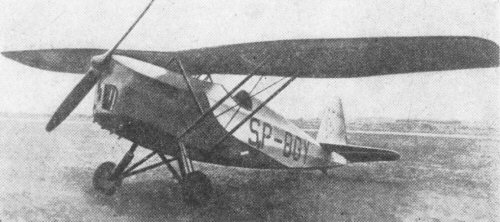- RWD-10
infobox Aircraft
name =RWD-10
type =Aerobatics plane
manufacturer =DWL
caption =
designer = RWD team
first flight =July 1933
introduced =1935
retired =1939
status =
primary user =Poland
more users =
produced =1937 -1938
number built =~22+1
unit cost =
variants with their own articles = The RWD-10 was a Polishaerobatics sports plane , single-seatparasol wing monoplane, used from 1933 to 1939 by the Polish aviation, constructed by the RWD team.Development
The aircraft was designed as a single-seater aerobatic sports plane, that could also be used as a trainer for
fighter aircraft pilots. The main designer wasJerzy Drzewiecki of the RWD construction team in the DWL ("Doświadczalne Warsztaty Lotnicze ") workshops. Its silhouette was similar to theRWD-8 . The first prototype (registration SP-ALC), was flown in July 1933 by Drzewiecki. Its stability was not satisfactory, but after modifications, including lengthening a fuselage, it appeared a successful design and it completed state trials in 1935. In a mock dogfight with thePZL P.11 c fighter, the RWD-10 kept on the P.11's tail. The first public aerobatics show of the RWD-10 took place during aGordon Bennett Cup in ballooning in September 14-15, 1935 in Warsaw.In
1936 , a series of 20 aircraft was ordered by theLOPP paramilitary organization, funded by a public collection for aviation development. They were built in 1937 and then distributed among the Polish regional aero clubs - most (5) for Warsaw Aero Club. In 1938, another two were built. In total, approximately 22 serial RWD-10s were produced.Three aircraft were crashed before the war, the rest were probably destroyed during the Invasion of Poland in
1939 .Description
Mixed construction single-engine single-seat braced high-wing (
parasol wing ) monoplane, conventional in layout. Fuselage of a steel frame, covered with canvas on a wooden frame, in aluminum in engine section. Straight double-trapezoid two-part wing, of wooden construction, covered with canvas and plywood in front, two-spar. The wing was supported by a central pyramid and twin struts. Wooden construction cantileverempennage , covered with plywood (stabilizers) and canvas (rudder and elevators). A pilot in an open cockpit, had a windshield. Conventional fixedlanding gear , with a rear skid. Four-cylinder air-cooled invertedstraight engine PZInż. Junior (licence builtWalter Junior ) with 82 kW (110 hp) nominal power and 90 kW (120 hp) take-off power. Two-blade wooden propeller Szomański, of a fixed pitch. Fuel tank in the fuselage: 54 l (fuel consumption 25 l/h).pecifications (RWD-10)
aircraft specifications
plane or copter?=plane
jet or prop?=prop
ref=Glass, A. (1977)
crew=One, pilot
capacity=
payload main=
payload alt=
length main= 6.2 m
length alt= 20 ft 4 in
span main= 7.5 m
span alt= 24 ft 7 in
height main= 1.9 m
height alt= 6 ft 3 in
area main= 9 m²
area alt= 96.65 ft²
airfoil=
empty weight main= 350 kg
empty weight alt= 770 lb
loaded weight main= 475 kg
loaded weight alt= 1,050 lb
useful load main= 125 kg
useful load alt= lb
max takeoff weight main=
max takeoff weight alt=
more general=
engine (prop)= PZInż. Junior
type of prop= 4-cylinder air-cooled invertedstraight engine
number of props=1
power main= 120 hp
power alt= 90 kW
power original=
max speed main=218 km/h
max speed alt= 135 mph
cruise speed main= 180 km/h
cruise speed alt=mph
stall speed main= 95 km/h
stall speed alt= mph
never exceed speed main=
never exceed speed alt=
range main= 360 km
range alt=224 mi
ceiling main= 6,000 m
ceiling alt= 19,680 ft
climb rate main= 6.2 m/s, 372 m/min
climb rate alt= 1,220 ft/min
loading main= 53 kg/m²
loading alt=10.9 lb/ft²
thrust/weight=
power/mass main=
power/mass alt=
more performance=
*Take-off: 70 m
*Landing: 100 mee also
aircontent
related=
similar aircraft=
*Focke-Wulf Fw 56 lists=
see also=References
* Glass, Andrzej: "Polskie konstrukcje lotnicze 1893-1939" ("Polish aviation constructions 1893-1939"), WKiŁ, Warsaw 1977, p. 308-311 pl icon
External links
* [http://www.airwar.ru/enc/other2/rwd10.html photos and drawings at Ugolok Neba site]
Wikimedia Foundation. 2010.
